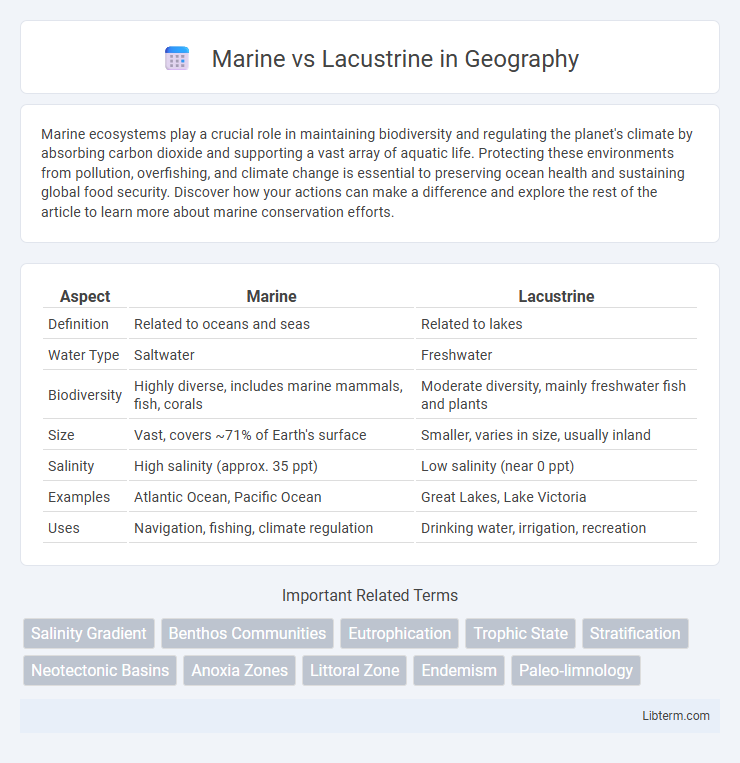Marine ecosystems play a crucial role in maintaining biodiversity and regulating the planet's climate by absorbing carbon dioxide and supporting a vast array of aquatic life. Protecting these environments from pollution, overfishing, and climate change is essential to preserving ocean health and sustaining global food security. Discover how your actions can make a difference and explore the rest of the article to learn more about marine conservation efforts.
Table of Comparison
| Aspect | Marine | Lacustrine |
|---|---|---|
| Definition | Related to oceans and seas | Related to lakes |
| Water Type | Saltwater | Freshwater |
| Biodiversity | Highly diverse, includes marine mammals, fish, corals | Moderate diversity, mainly freshwater fish and plants |
| Size | Vast, covers ~71% of Earth's surface | Smaller, varies in size, usually inland |
| Salinity | High salinity (approx. 35 ppt) | Low salinity (near 0 ppt) |
| Examples | Atlantic Ocean, Pacific Ocean | Great Lakes, Lake Victoria |
| Uses | Navigation, fishing, climate regulation | Drinking water, irrigation, recreation |
Introduction to Marine and Lacustrine Environments
Marine environments encompass vast saltwater ecosystems such as oceans, seas, and coastal regions characterized by high salinity, diverse marine life, and complex chemical and physical processes. Lacustrine environments refer to freshwater habitats within lakes and reservoirs, featuring distinct hydrological conditions, sedimentation patterns, and biotic communities adapted to low salinity. Both environments play crucial roles in global biogeochemical cycles and support unique ecological dynamics influenced by water chemistry, temperature, and nutrient availability.
Defining Marine Ecosystems
Marine ecosystems encompass vast oceanic environments characterized by saline water, including coastal zones, coral reefs, and deep-sea habitats, supporting diverse marine life adapted to high salinity and varying pressure conditions. These ecosystems are defined by physical factors such as tidal influences, ocean currents, and saline content, which shape biological communities and nutrient cycles distinct from freshwater systems. Marine ecosystems play a crucial role in global climate regulation, carbon sequestration, and sustenance of economic activities like fisheries and tourism.
Understanding Lacustrine (Lake) Systems
Lacustrine systems are inland freshwater environments characterized by sediment deposition in lakes, often featuring fine-grained sediments such as clays and silts. These systems support diverse ecological habitats and exhibit unique sedimentary structures unlike marine environments, with fluctuations driven by climatic variations and watershed inputs. Understanding lacustrine sedimentology provides crucial insights into past climate changes, freshwater resource management, and basin evolution.
Key Physical Differences Between Marine and Lacustrine Habitats
Marine habitats are characterized by saltwater conditions with high salinity levels averaging around 35 ppt, extensive depths reaching thousands of meters, and tidal influences that drive water movement. Lacustrine habitats are freshwater environments found in lakes, featuring low salinity, generally shallower depths often less than 200 meters, and more stable water levels without tidal effects. Temperature variation and nutrient availability also differ, with marine systems showing more complex thermoclines and greater nutrient mixing compared to often stratified and nutrient-limited lacustrine ecosystems.
Salinity Variations: Ocean vs. Lake
Marine environments typically exhibit stable salinity levels averaging around 35 parts per thousand, influenced by processes such as evaporation, precipitation, and ocean currents. Lacustrine salinity varies widely, ranging from nearly freshwater in most lakes to hypersaline conditions in endorheic basins like the Great Salt Lake, depending on local climate and inflow/outflow dynamics. These salinity variations critically affect the biodiversity, water chemistry, and ecological function of marine versus freshwater lake systems.
Biodiversity Comparison: Marine vs. Lacustrine Life
Marine ecosystems support higher biodiversity due to vast habitat variety, including coral reefs, deep-sea vents, and coastal estuaries, which host millions of species ranging from microscopic plankton to large marine mammals. Lacustrine environments, or freshwater lakes, have more limited biodiversity, dominated by fish, amphibians, aquatic plants, and invertebrates adapted to stable, enclosed water bodies with fewer nutrient inputs. Species richness in marine habitats surpasses lacustrine systems because of greater salinity tolerance, larger spatial scale, and complex food webs sustaining diverse biological communities.
Ecological Roles and Functions
Marine ecosystems provide essential ecological roles such as supporting vast biodiversity, regulating global climate through carbon sequestration, and maintaining nutrient cycling in ocean waters. Lacustrine environments contribute to freshwater biodiversity, act as critical habitats for numerous endemic species, and support nutrient retention and transformation processes within inland water systems. Both systems play pivotal functions in sustaining biological productivity and maintaining ecological balance across aquatic landscapes.
Human Impacts on Marine and Lacustrine Environments
Human activities have significantly altered both marine and lacustrine environments through pollution, habitat destruction, and overexploitation of resources. Coastal development, agricultural runoff, and industrial discharges contribute to nutrient loading and chemical contamination in marine and freshwater systems, leading to eutrophication and biodiversity loss. Overfishing and invasive species introductions further disrupt ecological balance, impacting the sustainability of aquatic ecosystems globally.
Conservation Challenges in Marine and Lacustrine Systems
Marine ecosystems face conservation challenges such as rising ocean temperatures, acidification, and overfishing that threaten biodiversity and habitat stability. Lacustrine environments struggle with pollution from agricultural runoff, invasive species, and hydrological alterations affecting water quality and native species survival. Effective conservation requires tailored strategies addressing specific stressors in both marine and lacustrine systems to maintain ecological balance.
Conclusion: Importance of Protecting Both Aquatic Environments
Marine and lacustrine ecosystems each play vital roles in biodiversity, climate regulation, and supporting human livelihoods through fisheries and water resources. Protecting both aquatic environments is crucial to maintaining ecological balance, preserving species diversity, and ensuring sustainable natural resources for future generations. Conservation strategies must address threats like pollution, habitat destruction, and climate change to safeguard the health of oceans and freshwater lakes worldwide.
Marine Infographic

 libterm.com
libterm.com